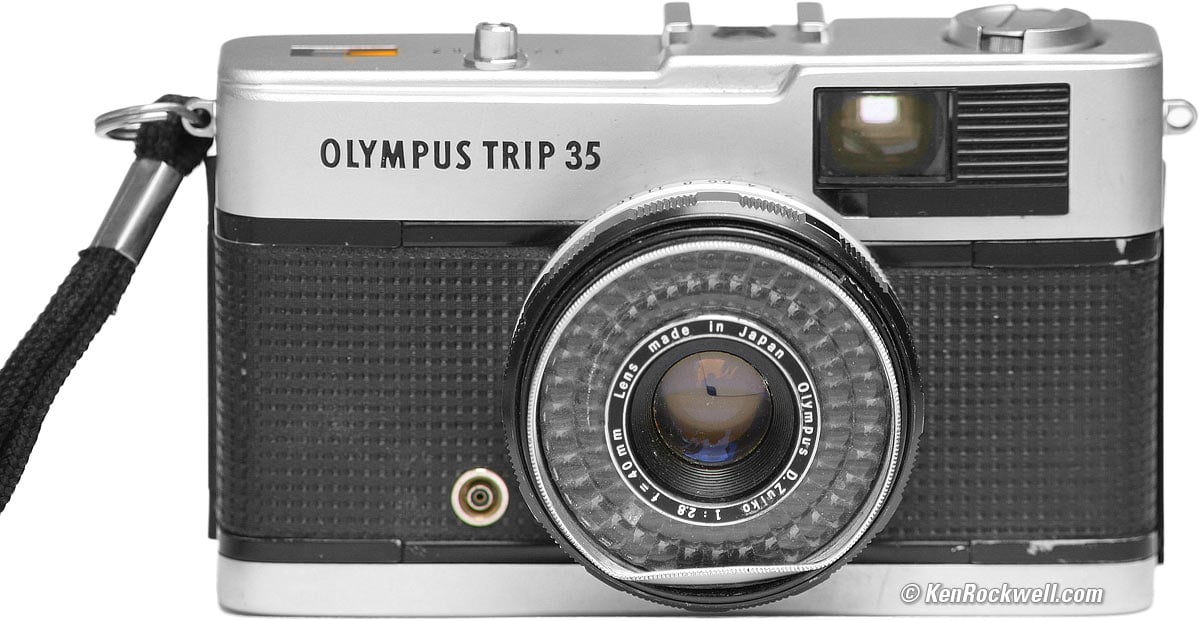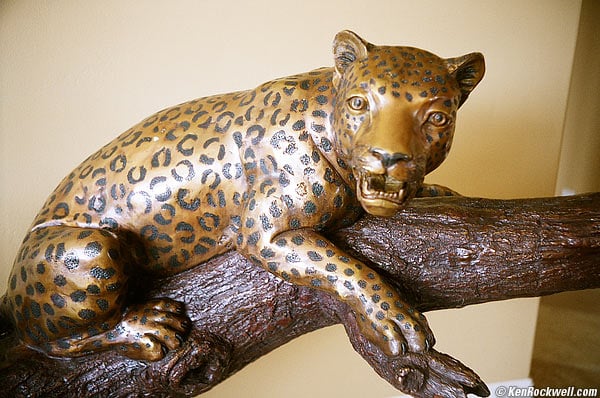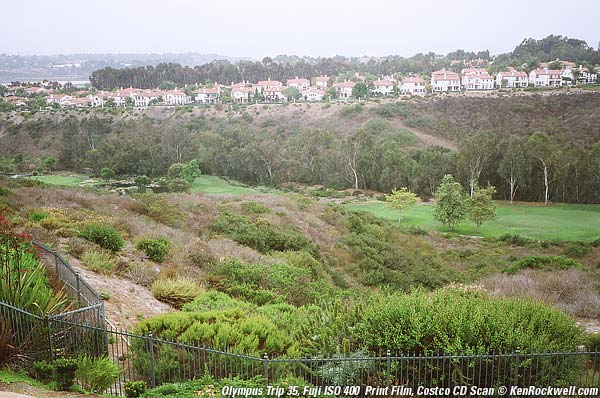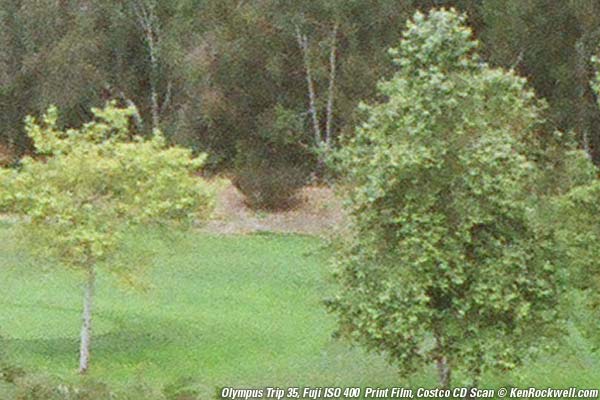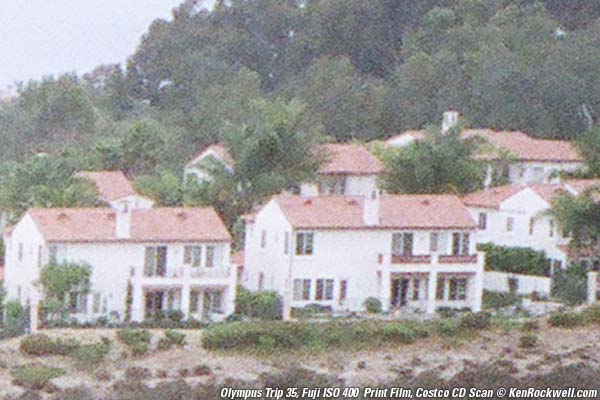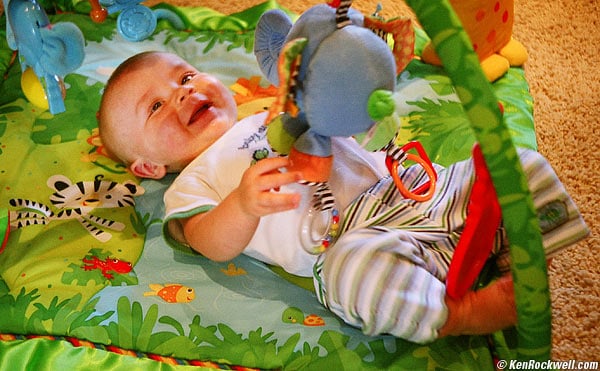Olympus Trip 35
(1968~1988)
Intro Specifications Performance User's Guide Recommendations More
Olympus Trip 35 (43.5mm filters, 13.8 oz./390g empty, 2.9'/0.9m close focus, about $75 used (2020)). bigger. I got this beat up camera (note bottom of filter ring) in a thrift shop for $5 in 2007. Today I'd get it at this link directly to them at eBay (see How to Win at eBay). Also check out this site in the UK which is totally dedicated to the Trip 35 and accessories, and even sells custom versions!
This all-content, junk-free website's biggest source of support is when you use those or any of these links to approved sources when you get anything, regardless of the country in which you live. Thanks for helping me help you! Ken.
07 July 2007 7/7/7 Olympus reviews all reviews
|
I buy only from these approved sources. I can't vouch for ads below. |
Intro Specifications Performance User's Guide Recommendations More
This is a fully automatic exposure 35mm film camera introduced in 1968. Olympus made over 10,000,000 of them through 1988. It was, and still is, an inexpensive, lightweight camera with few adjustments.
I bought this particular sample at a thrift shop for $5 on 7/7/7 with a dented filter ring. This one's date code says it was made in 1974.
The Olympus Trip 35 operates completely without batteries. Its light meter and programmed automatic exposure system is solar powered! This makes it one of the world's most advanced cameras which provides fully automatic exposure completely without batteries or external electrical power.
The examples below are from one 24-exposure test roll of ISO 400 print film.
Specifications top
Intro Specifications Performance User's Guide Recommendations More
Viewfinder
Standard Albada, with parallax marks. Red indication for too little light. Trick peephole to see exposure and focus settings as set on lens. The ridged window to the right of the finder window is fake, mimicking a rangefinder.
Focus
Manual by scale, visible through viewfinder. Top scale, visible through finder, shows icons or headshot (1m/3'), twoshot (1.5m/5'), group shot (3m/10') and infinity. Bottom scale calibrated in meters and feet.
Lens
40mm f/2.8 Olympus D. Zuiko.
4 elements, three groups.
Appears to be a front-element focusing Tessar.
Close Focus
2.9' (0.9m).
Diaphragm
Two bladed, diamond-shaped, stopping down to about f/22.
Shutter
1/40 or 1/200, automatically selected. No bulb setting.
Cable Release
Standard socket in shutter release button.
Meter
Selenium cell around lens. (automatically incorporates any filter factors.)
Exposure
Program automatic (A) and fixed-aperture for flash. Note: if you chose a large aperture for flash and work in bright light, it stops down accordingly but keeps the shutter speed at 1/40.
Exposure range
EV 8-1/3 (1/40 at f/2.8) to EV 17-1/6 (1/200 at f/27).
Film Speed
Third stops from ASA 25 - 400, except ASA 32.
Filter Size
43.5mm screw in.
Uniquely weird size deliberately chosen by Olympus to try to force you to buy their own brand of filters.
Low Light Warning
If exposure would go below 1/40 at f/2.8, the shutter locks and a red transparent flag rises from the bottom of the finder in A setting. (If this happens, use flash.)
Flash
Hot shoe and PC terminal.
Film Advance
Thumb wheel.
Rewind
Crank and bottom release button.
Back Opening
Catch along left bottom.
Film Loading
Put leader on tooth in slot.
Size
4.912" W x 2.861" H x 2.269" D (124.77mm W x 72.67mm H x 57.62mm D)l, measured.
Weight
13.77 oz. (390.5g), measured, naked: no film or strap.
Battery
NONE NEEDED.
La Pantera, by window light. Fuji Superia X-Tra 400 print film.
Performance back to top
Intro Specifications Performance User's Guide Recommendations More
Performance is great, in some ways better than the best digital cameras. Just set it to A and shoot, not worrying about anything. No delay, no waiting for AF, no WB setting, no battery charging, no wasting time looking at the LCD after each shot, no viewfinder blackout, no nothing - just great photos.
These shots are from a single 24-exp. roll of print film. I also shot a roll of Velvia, which looked looked great and super-sharp, too. Exposure was fine, even for slide film.
The light meter seems to see a broader area than just the subject, so it automatically compensates for subjects lighter or darker than their surroundings. Exposures on my first roll of slide film seem remarkably accurate!
Race Day
The BS stops when the green flag drops, so let's go whole hog and compare my $5 Olympus Trip 35 to my best-image-quality digital camera, my Canon 5D. I used my best Canon 17-40mm f/4L at 40mm to match the Olympus.
To handicap the Olympus, let's compare these in the digital domain, and let's shoot crappy print film and use only a 29¢ scan from Costco instead of shooting Fuji Velvia with a drum scan. Of course if we compared optical prints it would be much fairer to the Olympus, since what you see here is greatly veiling what the Olympus can do.
Here's a shot from my first try-out roll of ISO 400 Fuji Superia X-TRA print film ($1 per roll at Costco with coupon). I had the print film developed, printed at 5x7" and scanned to CD for only $9, total, in an hour. (Prints not used here, just the scans on CD.)
Overall shot. Roll mouse over to compare to Canon 5D.
Criminy! Considering I made these snaps on the way out to church with the wife yelling at me to hurry up, except for the slightly different framing and slightly different magnification with both cameras at 40mm, it's astounding how closely the tones and colors match.
Crop from center right. Roll mouse over to compare to 100% crop from 5D image (13MP).
OK, so the $2,500 5D and $700 17-40mm lens is a little bit sharper than a 29¢ Costco scan from print film, in the center.
The 5D image seems cleaner due in part to noise reduction which smoothes over much of the image except for edges leading to a cartoonish effect, while the film image has no NR applied. Worse for the Olympus Trip 35 film image, I see that it has a weird diamond-shaped character to the noise, implying that the 3k x 2k resolution files I got on my CD were upsampled in the scanner before I got them. I could have applied NR to the film image, but to keep things as unfair as possible in favor of digital, I didn't.
Crop from top right. Roll mouse over to compare to 100% crop from 5D image (13MP). Sorry about the framing, I was rushed.
AHA! The Olympus Trip 35 is sharper, since the 17-40mm got a little softer in the corner and the Olympus' sharpness stayed as high as it was in the center.
These crops would print the entire image at 44 x 29" (110 x 70 cm) if you printed the entire image at this magnification. If you did print that big, would you be looking at prints this closely?
Summary: The Olympus Trip 35 has much less distortion (none) and seems sharper in the corners than my $3,200 Canon 5D combo. My Olympus Trip 35's finder doesn't black out at the instant of exposure like an SLR, and its f/2.8 lens a stop faster than my Canon 17-40mm f/4L. Not bad for five bucks, - but hold on - this was a crappy scan from print film. Heaven only knows how good the Olympus Trip 35 is with drum scanned Fuji Velvia slide film.
Hint: I suspect the Olympus' 40mm lens is a Tessar design, identical to the Nikon 45mm f/2.8 P. This design, over 100 years old, has a reputation of being insanely sharp.
Tech Details: 5D: ISO 400, 17-40mm at 40mm, 1/200 at f/10 (same presumably as the Olympus), 13 MP (4,368 x 2,912 pixels). Olympus: Pointed and shot, one-hour developing and checked the box to put photos on CD. . Costco CD scan was only 3,089 x 2,048 pixels, so I upsampled in Photoshop (Bicubic Sharper) to match the image size of the 5D for these comparison crops.
Ryan in the Jungle, shot by crappy available indoor light, no color adjustments, 400 print film.
Distortion
I see none, unlike my zoom lenses.
Nuclear Survivability
It's a good bet that this may be the most advanced camera left operating after a nuclear event. EMP, or electro-magnetic pulse, is what happens during a nuclear event. EMP will toast just about every digital camera and computer and anything that operates with transistors or ICs. Most EMP research and testing is still highly classified. Since there are no active components in the Olympus Trip 35, if the internal Galvanometer and selenium cell survive, you ought to be OK to go out and start taking pictures when all other electronic, digital and video cameras have died. Bonne Chance!
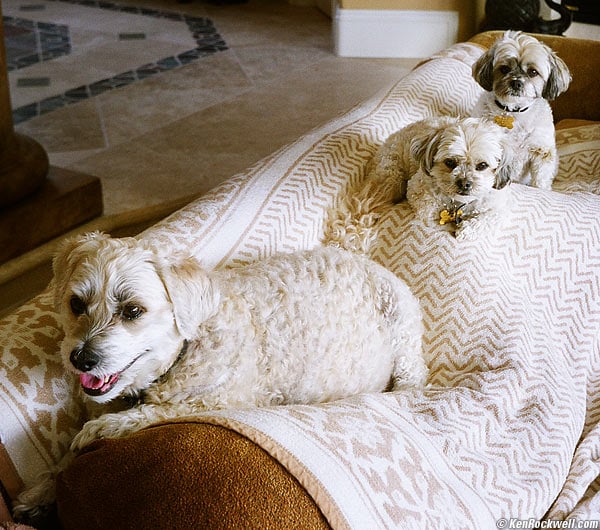
Buster, Megan and Molly, shot by window light, ISO 400 print film.
User's Guide top
Intro Specifications Performance User's Guide Recommendations More
Load, set the ASA (ISO) by turning the front filter ring and looking at the ASA window, wind the film, set the focus, point and shoot.
If it's too dark, the shutter locks. If so, put on a flash and set the aperture as needed. Compute the needed flash aperture either by guide number (there ought to be a calculator on the back of manual flashes) or set your flash to the A mode. In a flashes A mode, its calculator will tell you the f/stop to set on the camera.
Exposure lock: press shutter halfway. If you have strong back light, point the camera at something as bright as the subject, press and hold the shutter partway, recompose and shoot.
When you've finished the roll, push in the button on the bottom to release the film, wind the little crank on the top clockwise until you feel the end get taken up, pop open the back, pull up the crank, and take out the film.
Hint: I don't know if it's true, but one reader suggests keeping the lens capped when not in use to preserve the selenium cell. His Olympus Trip 35 has been in continuous use since the 1970s and still works perfectly. The low-light lock ensure you won't make any black pictures, brilliant thought on the part of Olympus!
Recommendations top
Intro Specifications Performance User's Guide Recommendations More
If you see one and it works, pick it up.
My sample was dropped and used, but since no one had ever opened it or tried to customize or repair it, it still works exactly as well as when it was new.
It even works great with picky Fuji Velvia slide film! I'm amazed at how well it works.
More Information top
Intro Specifications Performance User's Guide Recommendations More
Help Me Help You
I support my growing family through this website, as crazy as it might seem.
The biggest help is when you use any of these links when you get anything. It costs you nothing, and is this site's, and thus my family's, biggest source of support. These places always have the best prices and service, which is why I've used them since before this website existed. I recommend them all personally.
If you find this page as helpful as a book you might have had to buy or a workshop you may have had to take, feel free to help me continue helping everyone.
If you've gotten your gear through one of my links or helped otherwise, you're family. It's great people like you who allow me to keep adding to this site full-time. Thanks!
If you haven't helped yet, please do, and consider helping me with a gift of $5.00.
As this page is copyrighted and formally registered, it is unlawful to make copies, especially in the form of printouts for personal use. If you wish to make a printout for personal use, you are granted one-time permission only if you PayPal me $5.00 per printout or part thereof. Thank you!
Thanks for reading!
Mr. & Mrs. Ken Rockwell, Ryan and Katie.
